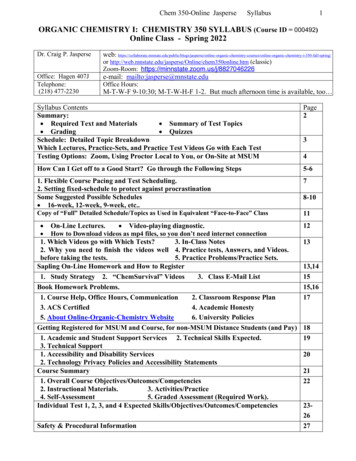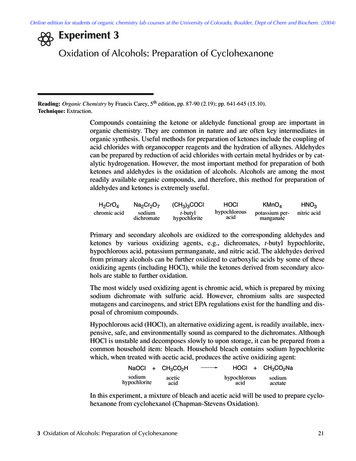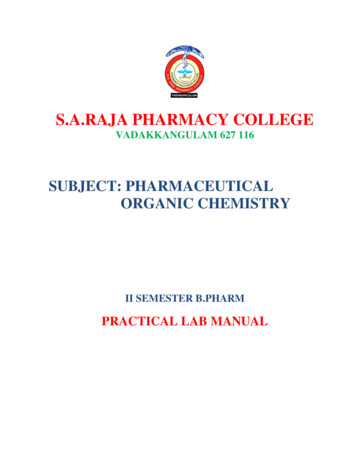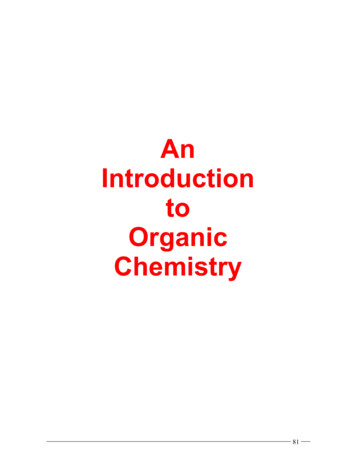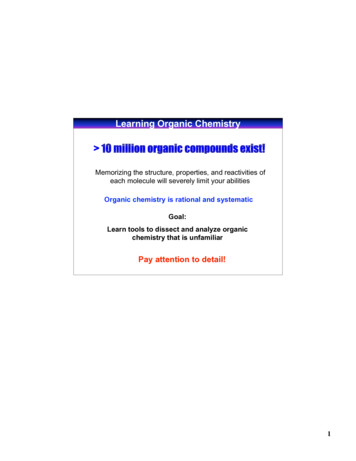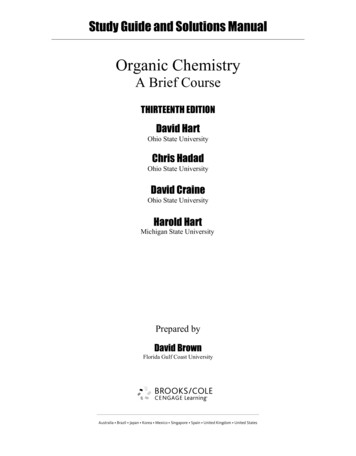
Transcription
Study Guide and Solutions ManualOrganic ChemistryA Brief CourseTHIRTEENTH EDITIONDavid HartOhio State UniversityChris HadadOhio State UniversityDavid CraineOhio State UniversityHarold HartMichigan State UniversityPrepared byDavid BrownFlorida Gulf Coast UniversityAustralia Brazil Japan Korea Mexico Singapore Spain United Kingdom United States
2013 Brooks/Cole, Cengage LearningALL RIGHTS RESERVED. No part of this work covered by thecopyright herein may be reproduced, transmitted, stored, orused in any form or by any means graphic, electronic, ormechanical, including but not limited to photocopying,recording, scanning, digitizing, taping, Web distribution,information networks, or information storage and retrievalsystems, except as permitted under Section 107 or 108 of the1976 United States Copyright Act, without the prior writtenpermission of the publisher.For product information and technology assistance, contact us atCengage Learning Customer & Sales Support,1-800-354-9706For permission to use material from this text or product, submitall requests online at www.cengage.com/permissionsFurther permissions questions can be emailed topermissionrequest@cengage.comPrinted in the United States of America1 2 3 4 5 6 7 16 15 14 13 12ISBN-13: 978-1-111-42952-2ISBN-10: 1-111-42952-9Brooks/Cole20 Davis DriveBelmont, CA 94002-3098USACengage Learning is a leading provider of customizedlearning solutions with office locations around the globe,including Singapore, the United Kingdom, Australia,Mexico, Brazil, and Japan. Locate your local office at:www.cengage.com/globalCengage Learning products are represented inCanada by Nelson Education, Ltd.To learn more about Brooks/Cole, visitwww.cengage.com/brookscolePurchase any of our products at your local collegestore or at our preferred online storewww.cengagebrain.com
ContentsIntroduction to the Student.vChapter 1: Bonding and Isomerism .1Chapter 2: Alkanes and Cycloalkanes; Conformational and Geometric Isomerism .18Chapter 3: Alkenes and Alkynes.34Chapter 4: Aromatic Compounds .58Chapter 5: Stereoisomerism . 82Chapter 6: Organic Halogen Compounds; Substitution and Elimination Reactions .102Chapter 7: Alcohols, Phenols, and Thiols.116Chapter 8: Ethers and Epoxides.134Chapter 9: Aldehydes and Ketones.149Chapter 10: Carboxylic Acids and Their Derivatives.175Chapter 11: Amines and Related Nitrogen Compounds.198Chapter 12: Spectroscopy and Structure Determination.219Chapter 13: Heterocyclic Compounds .233Chapter 14: Synthetic Polymers.249Chapter 15: Lipids and Detergents .263Chapter 16: Carbohydrates .274Chapter 17: Amino Acids, Peptides, and Proteins.298Chapter 18: Nucleotides and Nucleic Acids .326Summary of Synthetic Methods.341Summary of Reaction Mechanisms .354Review Problems On Synthesis .359Sample Multiple Choice Questions .363iii 2013 Cengage Learning. All Rights Reserved. May not be scanned, copied or duplicated, or posted to a publicly accessible website, in whole or in part.
Introduction to the StudentThis study guide and solutions book was written to help you learn organic chemistry. Theprinciples and facts of this subject are not easily learned by simply reading them, evenrepeatedly. Formulas, equations, and molecular structures are best mastered by writtenpractice. To help you become thoroughly familiar with the material, we have included manyproblems within and at the end of each chapter in the text.It is our experience that such questions are not put to their best use unless correctanswers are also available. Indeed, answers alone are not enough. If you know how to worka problem and find that your answer agrees with the correct one, fine. But what if you workconscientiously, yet cannot solve the problem? You then give in to temptation, look up theanswer, and encounter yet another dilemma–how in the world did the author get thatanswer? This solutions book has been written with this difficulty in mind. For many of theproblems, all of the reasoning involved in getting the correct answer is spelled out in detail.Many of the answers also include cross-references to the text. If you cannot solve aparticular problem, these references will guide you to parts of the text that you shouldreview.Each chapter of the text is briefly summarized. Whenever pertinent, the chaptersummary is followed by a list of all the new reactions and mechanisms encountered in thatchapter. These lists should be especially helpful to you as you review for examinations.When you study a new subject, it is always useful to know what is expected. To helpyou, we have included in this study guide a list of learning objectives for each chapter—thatis, a list of what you should be able to do after you have read and studied that chapter. Yourinstructor may want to delete items from these lists of objectives or add to them. However,we believe that if you have mastered these objectives—and the problems should help you todo this—you should have no difficulty with examinations. Furthermore, you should be verywell prepared for further courses that require this course as a prerequisite.Near the end of this study guide you will find additional sections that may help you tostudy for the final examination in the course. The SUMMARY OF SYNTHETIC METHODSlists the important ways to synthesize each class of compounds discussed in the text. It isfollowed by the SUMMARY OF REACTION MECHANISMS. Both of these sections havereferences to appropriate portions of the text, in case you feel that further review isnecessary. Finally, you will find two lists of sample test questions. The first deals withsynthesis, and the second is a list of multiple-choice questions. Both of these sets shouldhelp you prepare for examinations.In addition, we offer you a brief word of advice about how to learn the manyreactions you will study during this course. First, learn the nomenclature systems thoroughlyfor each new class of compounds that is introduced. Then, rather than memorizing theparticular examples of reactions given in the text, study reactions as being typical of a classof compounds. For example, if you are asked how compound A will react with compound B,proceed in the following way. First ask yourself: to what class of compounds does A belong?How does this class of compounds react with B (or with compounds of the general class towhich B belongs)? Then proceed from the general reaction to the specific case at hand. Thisapproach will probably help you to eliminate some of the memory work often associated withorganic chemistry courses. We urge you to study regularly, and hope that this study guideand solutions book will make it easier for you to do so.v 2013 Cengage Learning. All Rights Reserved. May not be scanned, copied or duplicated, or posted to a publicly accessible website, in whole or in part.
viIntroduction to the StudentGreat effort has been expended to ensure the accuracy of the answers in this bookand we wish to acknowledge the helpful comments provided by David Ball (Cleveland StateUniversity) in this regard. 2013 Cengage Learning. All Rights Reserved. May not be scanned, copied or duplicated, or posted to a publicly accessible website, in whole or in part.
1Bonding and IsomerismChapter SummaryAn atom consists of a nucleus surrounded by electrons arranged in orbitals. The electronsin the outer shell, or the valence electrons, are involved in bonding. Ionic bonds areformed by electron transfer from an electropositive atom to an electronegative atom.Atoms with similar electronegativities form covalent bonds by sharing electrons. A singlebond is the sharing of one electron pair between two atoms. A covalent bond has specificbond length and bond energy.Carbon, with four valence electrons, mainly forms covalent bonds. It usually formsfour such bonds, and these may be with itself or with other atoms such as hydrogen,oxygen, nitrogen, chlorine, and sulfur. In pure covalent bonds, electrons are shared equally,but in polar covalent bonds, the electrons are displaced toward the more electronegativeelement. Multiple bonds consist of two or three electron pairs shared between atoms.Structural (or constitutional) isomers are compounds with the same molecularformulas but different structural formulas (that is, different arrangements of the atoms inthe molecule). Isomerism is especially important in organic chemistry because of thecapacity of carbon atoms to be arranged in so many different ways: continuous chains,branched chains, and rings. Structural formulas can be written so that every bond is shown,or in various abbreviated forms. For example, the formula for n-pentane (n stands fornormal) can be written as:HHHHHHCCCCCHHHHHHorCH3CH2 CH2 CH2CH3orSome atoms, even in covalent compounds, carry a formal charge, defined as thenumber of valence electrons in the neutral atom minus the sum of the number of unsharedelectrons and half the number of shared electrons. Resonance occurs when we can writetwo or more structures for a molecule or ion with the same arrangement of atoms butdifferent arrangements of the electrons. The correct structure of the molecule or ion is aresonance hybrid of the contributing structures, which are drawn with a double-headedarrow ( ) between them. Organic chemists use a curved arrow ( ) to show the movementof an electron pair.A sigma ( ) bond is formed between atoms by the overlap of two atomic orbitalsalong the line that connects the atoms. Carbon uses sp3-hybridized orbitals to form foursuch bonds. These bonds are directed from the carbon nucleus toward the corners of atetrahedron. In methane, for example, the carbon is at the center and the four hydrogensare at the corners of a regular tetrahedron with H–C–H bond angles of 109.5 .In the chapter summaries, terms whose meanings you should know appear in boldface type.1 2013 Cengage Learning. All Rights Reserved. May not be scanned, copied or duplicated, or posted to a publicly accessible website, in whole or in part.
2Chapter 1Carbon compounds can be classified according to their molecular framework asacyclic (not cyclic), carbocyclic (containing rings of carbon atoms), or heterocyclic(containing at least one ring atom that is not carbon). They may also be classified accordingto functional group (Table 1.6).Learning Objectives1.Know the meaning of: nucleus, electrons, protons, neutrons, atomic number, atomicweight, shells, orbitals, valence electrons, valence, kernel.2.Know the meaning of: electropositive, electronegative, ionic and covalent bonds,radical, catenation, polar covalent bond, single and multiple bonds, nonbonding orunshared electron pair, bond length, bond energy.3.Know the meaning of: molecular formula, structural formula, structural (orconstitutional) isomers, continuous and branched chain, formal charge, resonance,contributing structures, sigma ( ) bond, sp3-hybrid orbitals, tetrahedral carbon.4.Know the meaning of: acyclic, carbocyclic, heterocyclic, functional group.5.Given a periodic table, determine the number of valence electrons of an element andwrite its electron-dot formula.6.Know the meaning of the following symbols: –7.Given two elements and a periodic table, tell which element is more electropositiveor electronegative.8.Given the formula of a compound and a periodic table, classify the compound asionic or covalent.9.Given an abbreviated structural formula of a compound, write its electron-dotformula.10.Given a covalent bond, tell whether it is polar. If it is, predict the direction of bondpolarity from the electronegativities of the atoms.11.Given a molecular formula, draw the structural formulas for all possible structuralisomers.12.Given a structural formula abbreviated on one line of type, write the completestructure and clearly show the arrangement of atoms in the molecule.13.(pentane), write the complete structure andGiven a line formula, such asclearly show the arrangement of atoms in the molecule. Tell how many hydrogensare attached to each carbon, what the molecular formula is, and what the functionalgroups are.14.Given a simple molecular formula, draw the electron-dot formula and determinewhether each atom in the structure carries a formal charge.Although the objectives are often worded in the form of imperatives (i.e., determine ,write , draw ), theseverbs are all to be preceded by the phrase “be able to ”. This phrase has been omitted to avoid repetition. 2013 Cengage Learning. All Rights Reserved. May not be scanned, copied or duplicated, or posted to a publicly accessible website, in whole or in part.
Bonding and Isomerism315.Draw the electron-dot formulas that show all important contributors to a resonancehybrid and show their electronic relationship using curved arrows.16.Predict the geometry of bonds around an atom, knowing the electron distribution inthe orbitals.17.Draw in three dimensions, with solid, wedged, and dashed bonds, the tetrahedralbonding around sp3-hybridized carbon atoms.18.Distinguish between acyclic, carbocyclic, and heterocyclic structures.19.Given a series of structural formulas, recognize compounds that belong to the sameclass (same functional group).20.Begin to recognize the important functional groups: alkene, alkyne, alcohol, ether,aldehyde, ketone, carboxylic acid, ester, amine, nitrile, amide, thiol, and thioether.ANSWERS TO PROBLEMSProblems Within the Chapter1.1The lithium atom donates its valence electron to the bromine atom to form the ioniccompound, lithium bromide.Li BrLi Br–1.2Elements with fewer than four valence electrons tend to give them up and formpositive ions: Al3 , Li . Elements with more than four valence electrons tend to gainelectrons to complete the valence shell, becoming negative ions: S2–, O2–.1.3Within any horizontal row in the periodic table, the most electropositive elementappears farthest to the left. Na is more electropositive than Al, and B is moreelectropositive than C. In a given column in the periodic table, the lower the element,the more electropositive it is. Al is more electropositive than B.1.4Within any horizontal row in the periodic table, the most electronegative elementappears farthest to the right. F is more electronegative than O, and O more than N.In a given column, the higher the element, the more electronegative it is. F is moreelectronegative than Cl.1.5As will be explained in Sec. 1.3, carbon is in Group IV and has a half-filled (or halfempty) valence shell. It is neither strongly electropositive nor stronglyelectronegative.1.6The unpaired electrons in the fluorine atoms are shared in the fluorine molecule.F Ffluorine atoms1.7dichloromethane (methylene chloride)HH C ClCl1.8Hor HC ClClF F heatfluorine moleculetrichloromethane (chloroform)ClH C ClClClor HC ClClIf the C–C bond length is 1.54 Å and the Cl–Cl bond length is 1.98 Å, we expect theC–Cl bond length to be about 1.76 Å: (1.54 1.98)/2. In fact, the C–Cl bond (1.75 Å)is longer than the C–C bond. 2013 Cengage Learning. All Rights Reserved. May not be scanned, copied or duplicated, or posted to a publicly accessible website, in whole or in part.
4Chapter 11.9PropaneHHHHCCCHHHH1.10N –Cl – ; S –O – The key to predicting bond polarities is to determine the relativeelectronegativities of the elements in the bond. In Table 1.4, Cl is moreelectronegative than N. The polarity of the S–O bond is easy to predict because bothelements are in the same column of the periodic table, and the more electronegativeatom appears nearer the top.1.11Both Cl and F are more electronegative than C.–F– Cl C Cl–F–1.12Both the C–O and H–O bonds are polar, and the oxygen is more electronegativethan either carbon or hydrogen.HHCOHH1.131.14H Ca.b.c.1.15NH CNH CNThe carbon shown has 12 electrons around it, 4 more than are allowed.There are 20 valence electrons shown, whereas there should only be 16 (6from each oxygen and 4 from the carbon).There is nothing wrong with this formula, but it does place a formal charge of–1 on the “left” oxygen and 1 on the “right” oxygen (see Sec. 1.11). Thisformula is one possible contributor to the resonance hybrid structure forcarbon dioxide (see Sec. 1.12); it is less important than the structure with twocarbon–oxygen double bonds, because it takes energy to separate the and– charges.Methanal (formaldehyde), H2CO. There are 12 valence electrons altogether (C 4,H 1, and O 6). A double bond between C and O is necessary to put 8 electronsaround each of these atoms.HH CHOorCOH1.16There are 10 valence electrons, 4 from C and 6 from O. An arrangement that puts8 electrons around each atom is shown below. This structure puts a formal charge of–1 on C and 1 on O (see Sec. 1.11).COorCO 2013 Cengage Learning. All Rights Reserved. May not be scanned, copied or duplicated, or posted to a publicly accessible website, in whole or in part.
Bonding and Isomerism1.175If the carbon chain is linear, there are two possibilities:HHCCCHHHHCHHandHHHHHCCCCHHHBut the carbon chain can be branched, giving a third e that the nitrogen has one non-bonded electron pair (part a) and the oxygenhas two non-bonded electron pairs (part b).1.19No, it does not. We cannot draw any structure for C2H5 that has four bonds to eachcarbon and one bond to each hydrogen.1.20First write the alcohols (compoundswith an O–H group).HHHHCCCHHHOHandHHHHCCCHOHHHThen write the structures with aC–O–C bond (ethers).HHCOHThere are no other possibilities. Forexample,HOHHHCCCHHHHHHCCHHandHHHHHCCCHHOHHare the same asHHHHCCCHHHOH 2013 Cengage Learning. All Rights Reserved. May not be scanned, copied or duplicated, or posted to a publicly accessible website, in whole or in part.
6Chapter 1They all have the same bond connectivities and represent a single structure. Similarly,HHCOHHHCCHHHis the same asHHHCCHH1.21From left to right: n-pentane, isopentane, and isopentane.1.22a.HHH CH CH CHHb.HClOHOCHHClCCHCClClHNotice that the non-bonded electron pairs on oxygen and chlorine are not shown.Non-bonded electron pairs are frequently omitted from organic structures, but it isimportant to know that they are there.01.23First draw the carbon skeleton showing all bonds between carbons.CCCCCCThen add hydrogens to satisfy the valency of four at each ands for the carbon skeletonCCCCH3CCCAddition of the appropriate number of hydrogens on each carbon completes thevalence of 4.H1.25ammoniaHformal charge on nitrogen 5 – (2 3) 0NHammonium ion HHNHformal charge on nitrogen 5 – (0 4) 1Hamide ionHN–formal charge on nitrogen 5 – (4 2) –1HThe formal charge on hydrogen in all three cases is zero [1 – (0 1) 0]. 2013 Cengage Learning. All Rights Reserved. May not be scanned, copied or duplicated, or posted to a publicly accessible website, in whole or in part.
Bonding and Isomerism1.267For the singly bonded oxygens, formal charge 6 – (6 1) –1.For the doubly bonded oxygen, formal charge 6 – (4 2) 0.For the carbon, formal charge 4 – (0 4) 0.2–OO1.27COThere are 24 valence electrons to use in bonding (6 from each oxygen, 5 from thenitrogen, and one more because of the negative charge). To arrange the atoms with8 valence electrons around each atom, we must have one nitrogen–oxygen doublebond:OONOOON–OOONOThe formal charge on nitrogen is 5 – (0 4) 1.The formal charge on singly bonded oxygen is 6 – (6 1) –1.The formal charge on doubly bonded oxygen is 6 – (4 2) 0.The net charge of the ion is –1 because each resonance structure has one positivelycharged nitrogen atom and two negatively charged oxygen atoms. In the resonancehybrid, the formal charge on the nitrogen is 1; on the oxygens, the charge is –2/3 ateach oxygen, because each oxygen has a –1 charge in two of the three structuresand a zero charge in the third structure.1.28There are 16 valence electrons (five from each N plus one for the negative charge).The formal charges on each nitrogen are shown below the structures.NNN–1 1 –1NNN0 1 –21.29In tetrahedral methane, the H–C–H bond angle is 109.5 . In “planar” methane, thisangle would be 90o and bonding electrons would be closer together. Thus, repulsionbetween electrons in different bonds would be greater in “planar” methane than intetrahedral methane. Consequently, “planar” methane would be less stable thantetrahedral methane.1.30a.b.c.d.C O, ketone; C C, alkene; O–H, alcoholarene; C( O)NH, amide; C–S–C, thioether, C( O)O–H, carboxylic acidC O, ketoneC C, alkene 2013 Cengage Learning. All Rights Reserved. May not be scanned, copied or duplicated, or posted to a publicly accessible website, in whole or in part.
8Chapter 1ADDITIONAL PROBLEMS1.31The number of valence electrons is the same as the number of the group to whichthe element belongs in the periodic table (Table The bonds in sodium chloride are ionic; Cl is present as chloride ion (Cl–); Cl– reactswith Ag to give AgCl, a white precipitate. The C–Cl bonds in CCl4 are covalent, noCl– is present to react with Ag .1.34a.b.c.d.e.f.b.f.ioniccovalentValence tcovalentCommon Valence212431Note that the sum of the number of valence electrons and the common valence is 8in each case. (The only exception is H, where it is 2, the number of electrons in thecompleted first shell.)1.35a.Hd.H1.36a.HHCCHHHHCNHH b.OHc.HHCFHHe.HHHCC ClHHf.HHHCCCHHHHHCOHBromine is more electronegative than hydrogen.–H Brb.HH- CFluorine is more electronegative than carbon.FHc.d.– –OCOCl ClThe C O bond is polar, and the oxygen is moreelectronegative than carbon.Since the bond is between identical atoms, it ispure covalent (nonpolar). 2013 Cengage Learning. All Rights Reserved. May not be scanned, copied or duplicated, or posted to a publicly accessible website, in whole or in part.
Bonding and Isomerisme.9Fluorine is more electronegative than sulfur.Indeed, it is the most electronegative element.Note that the S has 12 electrons around it.Elements below the first full row sometimes havemore than 8 valence electrons around them.-FFF -F SFFf.--Carbon and hydrogen have nearly identicalelectronegativities, and the bonds are essentiallynonpolar.HHCHHg.–O SOHh.HCOxygen is more electronegative than sulfur.– OOxygen is more electronegative than carbon, orhydrogen, so the C–O and O–H bonds are polarcovalent. HH1.37The O–H bond is polar (there is a big difference in electronegativity between oxygen andhydrogen), with the hydrogen . The C–H bonds in acetic acid are not polar (there islittle electronegativity difference between carbon and hydrogen). The negatively chargedoxygen of the carbonate hydroxide deprotonates the acetic acid.OO –CH3 C1.38a. NaOHOHC3H6CH3 CO– Na H2 OThere must be a double bond or, with three carbons, a ring:CH3 CHCH2orCH2H2 CCH2b.C3H7ClThe chlorine can replace a hydrogen on an end carbon or onthe middle carbon in the answer to a: CH3CH2CH2Cl orCH3CH(Cl)CH3c.C2H4F2The fluorines can either be attached to the same carbon or todifferent carbons:CH3CHF2 or CH2FCH2Fd.C3H8The only possible structure is CH3CH2CH3.e.C4H9FThe carbon chain may be either linear or branched. In eachcase there are two possible positions for the )CH2CH3(CH3)3CFBe systematic. With one chlorine on an end carbon, there arethree possibilities for the second chlorine. 2013 Cengage Learning. All Rights Reserved. May not be scanned, copied or duplicated, or posted to a publicly accessible website, in whole or in part.
10Chapter 1HCl HHCCCCl HHH Cl HHHCCCCl HHHHHH ClCCCCl HHHIf one chlorine is on the middle atom, the only new structurearises with the second chlorine also on the middle carbon:H Cl HHCCCHH Cl Hg.C4H10OWith an O–H bond, there are four CH(OH)CH2CH3(CH3)3C–OHThere are also three possibilities in a C–O–C .1.39C2H2I 2CH3CH2–O–CH2CH3The sum of the hydrogens and iodines is 4, not 6. Thereforethere must be a carbon–carbon double bond: I2C CH2 orCHI CHI. No carbocyclic structure is possible because thereare only two carbon atoms.The problem can be approached systematically. Consider first a chain of six carbons,then a chain of five carbons with a one-carbon branch, and so H3CH3CH3CHCHCH3CH3CH3CH2CCH3 CCCHHCHHHHCCHHHHc.HHHHHHCCNCCHHHHd.HHHHCCHHSH 2013 Cengage Learning. All Rights Reserved. May not be scanned, copied or duplicated, or posted to a publicly accessible website, in whole or in part.
Bonding and Isomerisme.H11HHCCHf.HCl OHH1.41a.CH3 CH2C(CH3 H2CH2CH 3h.HCH2CHCCCCCH1.42f.CH3CH2OCH 2CH3CH2H2CCH2OHHIn line formulas, each line segment represents a C–C bond, and C–H bondsare not shown (see Sec. 1.10). There are a number of acceptable linestructures for CH3(CH2)4CH3, three of which are shown here. The orientationof the line segments on the page is not important, but the number of linesegments connected to each point is important.orb.CH2CH3orBonds between carbon atoms and non-carbon atoms are indicated by linesegments that terminate with the symbol for the non-carbon atom. In thiscase, the non-carbon atom is an oxygen.OorOc.Bonds between hydrogens and non-carbon atoms are shown.OHorOHd.The same rules apply for cyclic structures. 2013 Cengage Learning. All Rights Reserved. May not be scanned, copied or duplicated, or posted to a publicly accessible website, in whole or in part.
12Chapter t count the carbons, then the hydrogens, and finally the remaining 2f.C10H14N21.45a.HONOFirst determine the total number of valence electrons; H 1,O 2 x 6 12, N 5, for a total of 18. These must bearranged in pairs so that the hydrogen has 2 and the otheratoms have 8 electrons around them.H O NOorHONOUsing the formula for formal charge given in Sec. 1.11, it canbe determined that none of the atoms has a formal charge.b.HONO2There are 24 valence electrons. The nitrogen has a 1 formalcharge [5 – (0 4) 1], and the singly bonded oxygen has a–1 formal charge [6 – (6 1)] –1. The whole molecule isneutral.OH O N(–1)O( 1)c.H2COThere are no formal charges.HH Cd.NH4 OThe nitrogen has a 1 formal charge; see the answer toProblem 1.25.H( 1)H N HHe.CN–There are 10 valence electrons (C 4, N 5, plus 1 morebecause of the negative charge).–CNThe carbon has a –1 formal charge [4 – (2 3) –1].f.COThere are 10 valence electrons.(–1)CO( 1) 2013 Cengage Learning. All Rights Reserved. May not be scanned, copied or duplicated, or posted to a publicly accessible website, in whole or in part.
Bonding and Isomerism13The carbon has a –1 formal charge, and the oxygen has a 1formal charge. Carbon monoxide is isoelectronic with cyanideion but has no net charge (–1 1 0).g.BCl3 There are 24 valence electrons (B 3, Cl 7). The structure isusually written with only 6 electrons around the boron.ClCl BClIn this case, there are no formal charges. This structure showsthat BCl3 is a Lewis acid, which readily accepts an electronpair to complete the octet around the boron.H2O2h.There are 14 valence electrons and an O–O bond. There areno formal charges.H O O HHCO3–i.There are 24 valence electrons involved. The hydrogen isattached to an oxygen, not to carbon.OH O C OO(–1)orHOCO(–1)The indicated oxygen has a formal charge: 6 – (6 1) –1. Allother atoms are formally neutral.1.46This is a methyl carbocation, CH3 .HHCformal charge 4 – (0 3) 1HThis is a methyl free radical, CH3.HHCformal charge 4 – (1 3) 0HThis is a methyl carbanion, CH3– .HHCformal charge 4 – (2 3 ) –1HThis is a methylene or carbene, CH2.HHCformal charge 4 – (2 2) 0 2013 Cengage Learning. All Rights Reserved. May not be scanned, copied or duplicated, or posted to a publicly accessible website, in whole or in part.
14Chapter 1All of these fragments are extremely reactive. They may act as intermediates inorganic reactions.1.47There are 18 valence electrons (6 from each of the oxygens, 5 from the nitrogen, and1 from the negative charge).–1O
Isomerism is especially important in organic chemistry because of the capacity of carbon atoms to be arranged in so many different ways: continuous chains, branched chains, and rings. Structural formulas can be written so that every bond is shown, or in various abbreviated fo


